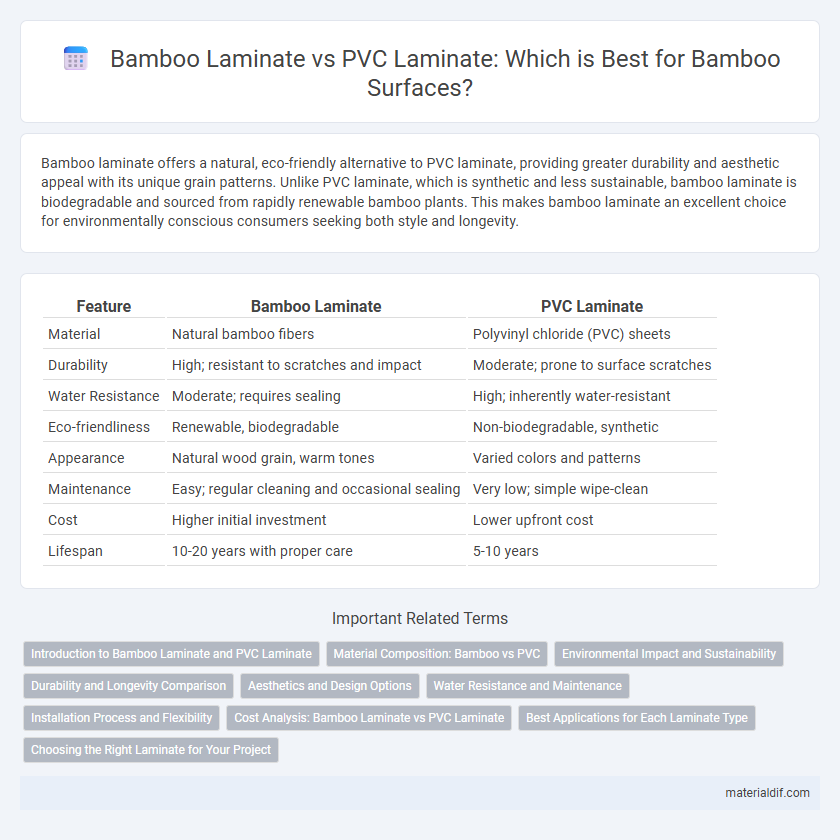Bamboo laminate offers a natural, eco-friendly alternative to PVC laminate, providing greater durability and aesthetic appeal with its unique grain patterns. Unlike PVC laminate, which is synthetic and less sustainable, bamboo laminate is biodegradable and sourced from rapidly renewable bamboo plants. This makes bamboo laminate an excellent choice for environmentally conscious consumers seeking both style and longevity.
Table of Comparison
| Feature | Bamboo Laminate | PVC Laminate |
|---|---|---|
| Material | Natural bamboo fibers | Polyvinyl chloride (PVC) sheets |
| Durability | High; resistant to scratches and impact | Moderate; prone to surface scratches |
| Water Resistance | Moderate; requires sealing | High; inherently water-resistant |
| Eco-friendliness | Renewable, biodegradable | Non-biodegradable, synthetic |
| Appearance | Natural wood grain, warm tones | Varied colors and patterns |
| Maintenance | Easy; regular cleaning and occasional sealing | Very low; simple wipe-clean |
| Cost | Higher initial investment | Lower upfront cost |
| Lifespan | 10-20 years with proper care | 5-10 years |
Introduction to Bamboo Laminate and PVC Laminate
Bamboo laminate consists of thin layers of natural bamboo fibers fused together under heat and pressure to create a durable, eco-friendly surface commonly used in flooring and furniture. PVC laminate, made from polyvinyl chloride, offers water-resistant, low-maintenance characteristics suitable for high-moisture environments but lacks the natural aesthetic of bamboo. Both materials serve as sustainable alternatives to traditional wood laminates, with bamboo emphasizing renewable resources and PVC highlighting synthetic durability.
Material Composition: Bamboo vs PVC
Bamboo laminate is made from natural bamboo fibers compressed with adhesives, offering a renewable, eco-friendly alternative with high durability and a unique fiber grain texture. PVC laminate consists of synthetic polyvinyl chloride resin layers combined with plasticizers, making it moisture-resistant but less sustainable and prone to chemical emissions. The inherent natural composition of bamboo provides biodegradable properties and superior breathability compared to the non-biodegradable, plastic-based PVC laminate.
Environmental Impact and Sustainability
Bamboo laminate offers a significantly lower environmental impact compared to PVC laminate due to its rapid renewability and biodegradability. Bamboo grows quickly without the need for pesticides or fertilizers, making it a sustainable resource, whereas PVC production relies on non-renewable fossil fuels and generates harmful greenhouse gases. Disposal of bamboo laminate results in minimal pollution, contrasting sharply with PVC laminate's contribution to long-lasting plastic waste and toxic chemical leaching.
Durability and Longevity Comparison
Bamboo laminate offers superior durability due to its dense fiber structure, making it more resistant to scratches and dents compared to PVC laminate. Bamboo's natural resilience enhances its longevity, often lasting over 20 years with proper maintenance, while PVC laminate typically endures 10-15 years before showing significant wear. The eco-friendly composition of bamboo laminate also maintains its integrity under varying humidity and temperature conditions better than synthetic PVC options.
Aesthetics and Design Options
Bamboo laminate offers a natural, warm aesthetic with unique grain patterns that enhance interior design through its organic texture and rich color variations. In contrast, PVC laminate provides a wider range of design options including customizable patterns, colors, and finishes but may lack the authentic feel of real wood. Bamboo laminate supports eco-friendly design trends, making it a preferred choice for sustainable and visually appealing surfaces.
Water Resistance and Maintenance
Bamboo laminate offers superior water resistance compared to PVC laminate due to its natural fibrous structure treated with water-repellent finishes, making it less prone to swelling and warping. Maintenance for bamboo laminate involves regular cleaning with mild detergents and avoiding excessive moisture, while PVC laminate requires minimal upkeep but can degrade under prolonged exposure to water and UV light. Choosing bamboo laminate ensures a durable, eco-friendly surface with better performance in humid or wet environments.
Installation Process and Flexibility
Bamboo laminate offers a straightforward installation process with click-lock systems that enhance its flexibility, allowing it to conform well to uneven surfaces and various room shapes. In contrast, PVC laminate often requires adhesive application, which can complicate installation and reduce adaptability to subfloor irregularities. Bamboo's natural material composition provides superior resilience and a more eco-friendly option compared to synthetic PVC laminates.
Cost Analysis: Bamboo Laminate vs PVC Laminate
Bamboo laminate generally offers a higher initial cost compared to PVC laminate due to its natural material and sustainable sourcing, but it provides greater long-term value through durability and eco-friendly benefits. PVC laminate is typically less expensive upfront and widely available, making it a popular choice for budget-conscious projects. However, bamboo laminate's superior lifespan and resistance to wear often result in lower maintenance and replacement expenses over time, offering a cost-effective investment despite the higher initial price.
Best Applications for Each Laminate Type
Bamboo laminate offers superior durability and natural aesthetic appeal, making it ideal for flooring, furniture, and decorative wall panels that require a sustainable and eco-friendly material. PVC laminate excels in moisture resistance and versatility, making it perfect for kitchens, bathrooms, and commercial spaces where water exposure and easy maintenance are critical. Choosing bamboo laminate enhances indoor air quality and sustainability, while PVC laminate provides cost-effective solutions with a wide range of design options.
Choosing the Right Laminate for Your Project
Bamboo laminate offers superior eco-friendliness and durability due to its natural composition and renewable sourcing, making it ideal for sustainable construction projects. PVC laminate provides greater moisture resistance and is highly customizable with various colors and textures, suitable for areas prone to humidity. Choosing between bamboo and PVC laminate depends on project priorities such as environmental impact, durability, moisture exposure, and aesthetic preferences.
Bamboo laminate vs PVC laminate Infographic

 materialdif.com
materialdif.com